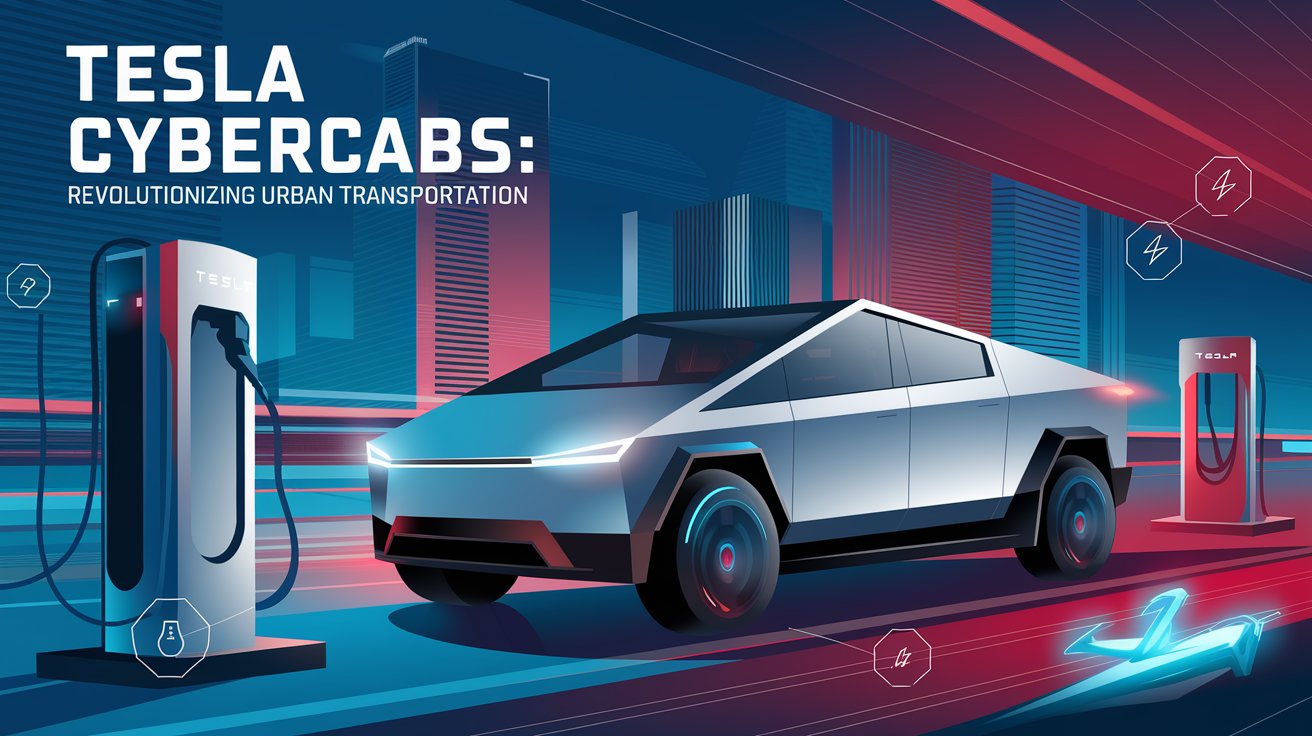Tesla has long been synonymous with innovation in the electric vehicle (EV) sector, and their latest announcement at the We, Robot event marks yet another bold leap forward. Tesla CEO Elon Musk unveiled 20 Cybercabs, an innovative line of autonomous electric taxis, at the highly anticipated event, which has garnered significant attention within the tech and automotive industries. Musk also made waves with a promise that these futuristic vehicles will be available to the public at a price point below $30,000—an aggressive and competitive move that could reshape the ride-hailing and EV markets.
This announcement is part of Tesla’s broader vision of an autonomous, sustainable future. The Cybercab, designed with sleek, angular aesthetics reminiscent of the Cybertruck, promises to not only revolutionize urban transportation but also make autonomous electric vehicles more accessible to a wider audience. The Cybercab is set to challenge conventional taxi services by offering a cleaner, safer, and more efficient alternative to gasoline-powered cabs, all at a price point that significantly lowers the barriers to entry for potential buyers.
This blog delves into the major takeaways from the Cybercab unveiling, exploring the implications of the technology, the price point, and Tesla’s vision for the future of transportation.
Cybercabs: A New Era in Urban Transportation
The concept of autonomous taxis has been on the horizon for several years, but Tesla’s Cybercabs take this vision a step further by offering fully electric, driverless cabs designed to make urban commuting more sustainable and efficient. At the We, Robot event, Musk emphasized that the Cybercab’s introduction is not just about providing a new transportation option—it’s about rethinking how we move within cities.
Tesla’s Cybercab is built to leverage the company’s proprietary Full Self-Driving (FSD) technology, which has already been in development for years. The FSD system, integrated with advanced sensors, cameras, and artificial intelligence, allows the vehicle to operate without human intervention, making autonomous ride-hailing a reality. As part of its safety protocols, the Cybercab is equipped with a comprehensive set of redundancies in braking, steering, and navigation to ensure a safe and reliable ride, even in busy urban environments.
By introducing Cybercabs, Tesla is addressing some of the most pressing challenges in urban transportation: traffic congestion, emissions, and the high costs associated with traditional taxi services. The Cybercab, which operates entirely on electricity, aims to cut down on emissions while providing a cleaner alternative to the gasoline-fueled taxis that currently dominate the market. Additionally, without the need for human drivers, Tesla hopes to reduce operating costs for taxi companies and ride-hailing services, making affordable transportation accessible to more people.
The $30K Promise: Affordability in the Autonomous Age
One of the most surprising aspects of Tesla’s announcement was the promised price tag: less than $30,000. Given the advanced technology packed into the Cybercab, this price point is lower than what many analysts expected for an autonomous vehicle, especially one built by Tesla. Musk’s declaration underscores Tesla’s commitment to making electric and autonomous vehicles accessible to a broader market, rather than reserving them for luxury buyers or tech enthusiasts.
While autonomous vehicles have typically been associated with high costs due to the advanced technology required for self-driving capabilities, Tesla has long prided itself on its ability to drive down manufacturing costs through innovations in battery production and assembly line efficiency. With the launch of the Cybercab, Tesla aims to further disrupt the automotive market by offering an autonomous vehicle at a price that is competitive with traditional, non-autonomous vehicles.
This affordability could accelerate the adoption of autonomous technology, particularly for commercial applications. Fleet operators, ride-hailing companies, and transportation startups may find the Cybercab an attractive option for replacing their fleets, as the low price point offers a clear path to profitability in a sector where margins are often thin. For consumers, the idea of owning a Tesla-branded autonomous vehicle for less than $30,000 could open up new possibilities for personal transport, particularly in urban areas where owning a car is often seen as unnecessary or prohibitively expensive.
Cybercab Design and Features: A Glimpse of the Future
Tesla has always prioritized design, and the Cybercab is no exception. The design of the Cybercab shares its DNA with Tesla’s Cybertruck, featuring angular lines and a futuristic aesthetic that stands out in the crowd. At the We, Robot event, attendees noted the sleek, minimalist design of the vehicle, which reflects both functionality and the company’s forward-thinking design ethos.
Inside, the Cybercab is designed to provide a spacious, comfortable experience for passengers. Without a human driver, the front of the vehicle has been reimagined to offer additional space for passengers or luggage. Additionally, the Cybercab will likely feature Tesla’s signature infotainment system, complete with touchscreen displays, wireless connectivity, and advanced climate control.
One of the most notable design aspects of the Cybercab is its bi-directional capability—the cab can drive in either direction without needing to turn around. This feature, coupled with its compact design, makes the Cybercab ideal for navigating narrow streets and congested urban environments. It’s a practical solution to one of the significant challenges faced by urban taxis: maneuverability in dense city areas.
The Cybercab also incorporates Tesla’s cutting-edge battery technology. Musk has hinted that the Cybercab’s range will be impressive, allowing it to operate for extended periods without needing to recharge. This long-range capability is essential for maximizing the uptime of these autonomous cabs, reducing the need for frequent recharging stops, and ensuring continuous service during peak demand periods.
Tesla’s Full Self-Driving Technology: A Critical Enabler
At the heart of the Cybercab’s functionality is Tesla’s Full Self-Driving (FSD) system, which continues to push the boundaries of what autonomous vehicles can achieve. FSD uses a combination of cameras, sensors, and artificial intelligence to navigate roads, avoid obstacles, and make real-time decisions about driving conditions. As the Cybercab is fully autonomous, FSD plays a pivotal role in ensuring that the vehicle operates safely and efficiently.
Musk and Tesla have been developing FSD technology for years, and while the company has faced its share of challenges—such as regulatory hurdles and questions about safety—FSD has continually improved. With the launch of the Cybercab, Tesla is betting that its autonomous technology is ready for widespread, commercial use.
FSD is integrated with Tesla’s fleet-learning technology, meaning that every Tesla vehicle equipped with FSD learns from the collective experiences of the entire fleet. This creates a continuous improvement cycle, where the system learns from real-world driving conditions across millions of miles. With each new software update, Tesla’s autonomous vehicles become smarter, safer, and more efficient, further enhancing the Cybercab’s potential as a reliable transportation solution.
Revolutionizing the Ride-Hailing Industry
The Cybercab has the potential to upend the ride-hailing industry, which is currently dominated by companies like Uber and Lyft that rely on human drivers. Autonomous taxis could drastically reduce the cost of rides, as the most significant expense—paying drivers—is eliminated. In theory, ride-hailing companies could lower their fares while maintaining profitability, making on-demand transportation even more affordable for consumers.
Tesla’s entry into the autonomous taxi market could also pave the way for Tesla Network, a rumored ride-hailing service that would allow Tesla owners to make their cars available for ride-sharing when they are not in use. Musk has previously hinted at this concept, describing a future where Tesla vehicles operate as autonomous taxis when their owners don’t need them, generating passive income for the vehicle’s owner. The Cybercab could be the first step in making this vision a reality, where Tesla owners, fleet operators, and ride-hailing companies all benefit from the scalability of autonomous vehicles.
Tesla’s Cybercab could also help address the issue of driver shortages, a problem currently plaguing many ride-hailing services. By removing the need for human drivers, Tesla’s autonomous taxis can operate 24/7, ensuring that customers have access to rides at all hours of the day. This continuous operation not only enhances the convenience for customers but also boosts the efficiency and profitability of ride-hailing services.
Environmental Impact and Sustainability
In addition to the technological advances and economic implications of the Cybercab, Tesla’s latest vehicle also aligns with the company’s broader mission of accelerating the transition to sustainable energy. The Cybercab, being fully electric, emits zero tailpipe emissions, making it a cleaner alternative to gasoline-powered taxis that contribute to urban pollution.
As cities around the world grapple with the consequences of climate change, transitioning to electric vehicles like the Cybercab is a crucial step in reducing greenhouse gas emissions and improving air quality. Urban centers, in particular, are likely to benefit from widespread adoption of electric taxis, as they help mitigate the harmful effects of vehicular pollution on both public health and the environment.
Tesla’s investment in battery recycling and renewable energy integration further enhances the sustainability of the Cybercab. By integrating the vehicle with Tesla’s energy storage solutions, such as Powerwall and Solar Roof, fleet operators can charge their vehicles using clean, renewable energy sources, reducing the carbon footprint of the entire ride-hailing ecosystem.
Conclusion: A Bold Vision for the Future of Transportation
Tesla’s unveiling of the Cybercab at the We, Robot event marks a significant milestone in the evolution of autonomous electric vehicles. With a promise of affordability, advanced autonomous capabilities, and a commitment to sustainability, the Cybercab represents a transformative leap forward for urban transportation.
As Tesla continues to innovate and expand its product offerings, the Cybercab could redefine how we think about mobility in cities. Whether it’s through revolutionizing the ride-hailing industry, reducing urban emissions, or making autonomous vehicles accessible to a broader audience, Tesla’s latest vehicle is poised to shape the future of transportation in profound ways.
The next few years will be criticalas Tesla continues to innovate and expand its product offerings, the Cybercab could redefine how we think about mobility in cities. Whether it’s through revolutionizing the ride-hailing industry, reducing urban emissions, or making autonomous vehicles accessible to a broader audience, Tesla’s latest vehicle is poised to shape the future of transportation in profound ways.
The next few years will be critical for seeing how well Tesla’s promise of affordable, autonomous vehicles can be realized, and whether the infrastructure and regulations can catch up with the rapid advancements in technology. Nevertheless, the Cybercab is yet another example of Tesla’s commitment to pushing boundaries and creating solutions that could transform urban living and transportation as we know it. With sustainability and affordability at the heart of the Cybercab project, this vehicle promises to be a game-changer for cities, consumers, and the environment alike.





